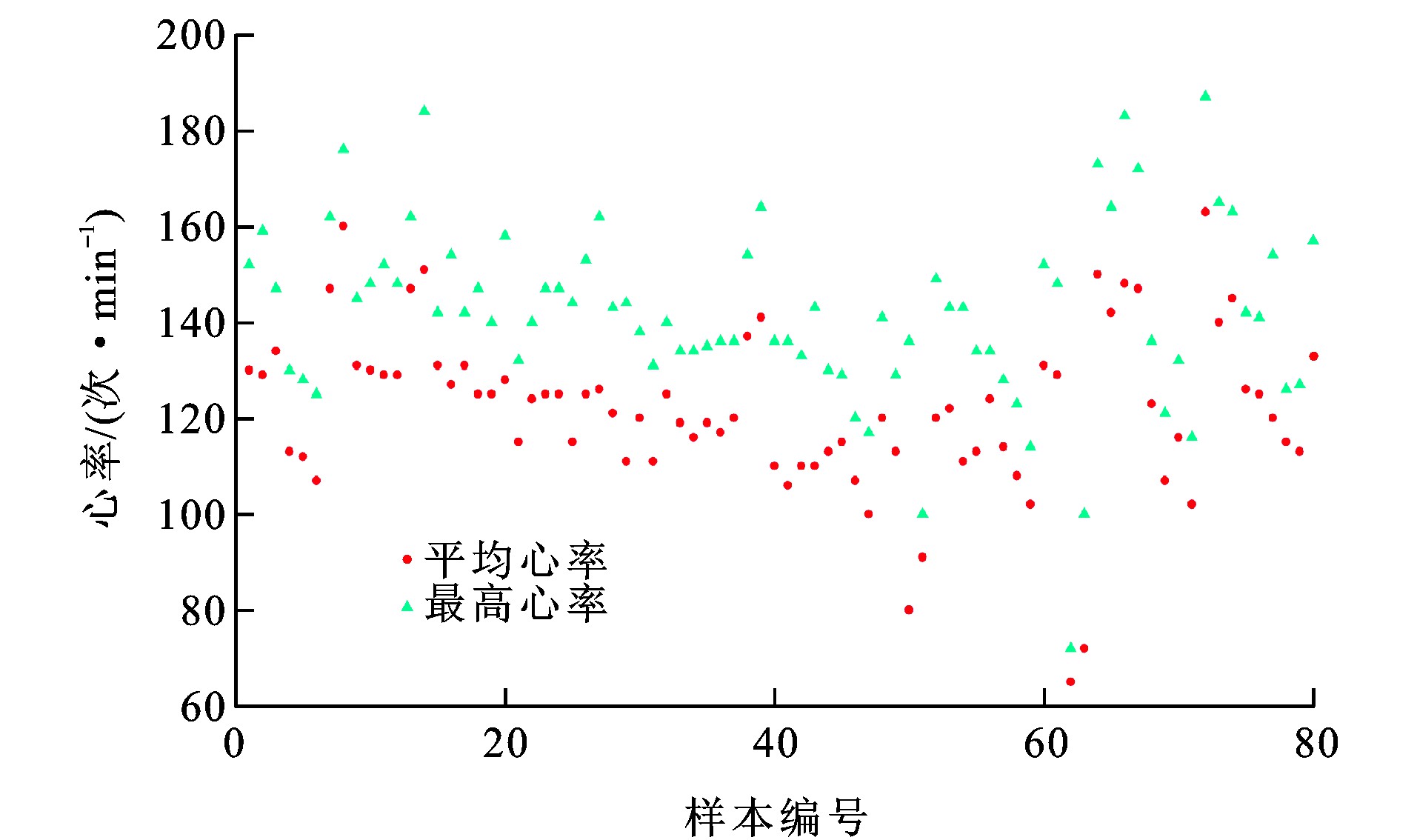Physiology, psychology and comprehensive loading perception models of cyclists
-
摘要: 为探究自行车骑行者在骑行过程中的生理、心理状态与骑行者个体属性、骑行强度及骑行环境之间的影响规律, 设计并实施了自行车骑行试验; 选取了相对代谢率、心境状态、自感疲劳程度和任务负荷指数等指标, 分析了骑行者生理、心理与综合负荷感知的特性及规律; 以骑行试验数据为基础, 应用偏最小二乘回归方法建立了骑行者生理、心理及综合负荷感知模型, 并对模型预测能力进行评估。研究结果表明: 骑行者个体属性、骑行强度及骑行环境均对骑行者负荷感知有影响, 其中骑行者个体属性因素中, 身体质量指数和基础代谢率作用较为显著, 二者在负荷感知模型中的平均影响因子分别为0.121和0.112;骑行强度因素中骑行时间对于负荷感知影响最大, 其平均影响因子为0.139;骑行环境因素中交叉口数对骑行负荷感知影响最为显著, 其平均影响因子为0.137;各个变量对心理负荷与综合负荷感知的影响趋势相同, 对生理负荷与综合负荷的影响趋势不相同。可见, 关注部分因素以及骑行者心理负荷对于提高骑行服务水平具有一定作用, 研究结果可应用于改善自行车骑行设施环境。Abstract: In order to explore the influence mechanisms of cyclists' physiological and psychological states on the individual attributes, cycling intensity and environment during the cycling process, the cycling experiment was designed and implemented. The relative metabolism rate, mood state, self-induced fatigue and task load index were selected to analyze the features and mechanisms of the cyclists' physiological, psychological and comprehensive loading perception. Based on the cycling experiment data, the physiological, psychological and comprehensive loading perception models were established by partial least-squares regression method, and the forecasting abilities of the models were also tested. Analysis result shows that cyclists' individual attributes, cycling intensity and environment all have impacts on cyclists' loading perception. Body mass index and basal metabolic rate play significant roles in individual attribute factors of cyclists, the average influence factors in the loading perception model are 0.121 and 0.112, respectively. Cycling time has the largest influence on loading perception among the cycling intensity factors, with an average influence factor of 0.139. Among the cycling environmental factors, the number of intersections has the most significant influence on cycling loading perception, with an average influence factor of 0.137. Each variable has the same influence tendency on psychological load and comprehensive load perception, but has different influence tendency on physiological load and comprehensive load. Therefore, paying more attention to some factors and the psychological load of cyclists has certain effects on improving the service level of cycles, and the research results can be applied to improve the environment of cycling facilities.
-
Key words:
- slow traffic /
- cyclists /
- partial least-square regression /
- perception model /
- physiology load /
- psychology load
-
表 1 骑行影响因素
Table 1. Influence factors of cycling
类别 骑行环境 骑行强度 个体属性 影响因素 机非隔离形式、自行车道宽度、交叉口数、道路类型、公交站点数、公交线路数 骑行时间、骑行距离、平均速度 身高、体重、年龄、性别、基础代谢率、身体质量指数 表 2 骑行道路状况
Table 2. Cycling road conditions
OD编号 骑行路径 路段编号 机非隔离形式 路段长度/km 自行车道宽度/m OD-1 A A-1 物理隔离 0.6 2.0 A-2 标线隔离 4.0 3.0 A-3 标线隔离 0.2 1.5 A-4 标线隔离 0.5 2.0 B B-1 物理隔离 0.6 2.0 B-2 标线隔离 4.3 3.5 B-3 标线隔离 0.5 2.0 B-4 物理隔离 0.6 2.0 C C-1 标线隔离 2.9 3.5 C-2 标线隔离 0.7 2.0 C-3 标线隔离 1.3 1.5 C-4 标线隔离 0.1 2.0 OD-2 D D-1 物理隔离 2.8 2.0 D-2 标线隔离 2.0 2.5 D-3 物理隔离 1.8 2.0 E E-1 物理隔离 1.4 2.5 E-2 物理隔离 0.8 3.0 E-3 标线隔离 1.1 2.5 F F-1 物理隔离 2.9 2.0 F-2 物理隔离 2.0 3.0 F-3 标线隔离 0.5 2.5 OD-3 G G-1 标线隔离 0.9 3.0 G-2 物理隔离 2.2 3.0 G-3 物理隔离 0.7 3.0 H H-1 标线隔离 2.3 2.5 H-2 物理隔离 1.5 3.0 表 3 实测数据
Table 3. Empirical data
个体属性数据 身高、体重、年龄、性别 骑行强度数据 骑行时间、骑行距离 骑行环境数据 机非隔离形式、自行车道宽度、公交站点数、公交线路数、交叉口数、道路类型 生理负荷评估 心率、相对代谢率、骑行前后疼痛量表评分 心理负荷评估 骑行前后的任务负荷指数量表评分、心境状态量表评分 综合负荷评估 骑行前后的自感疲劳程度量表评分、瑞士职业疲劳量表评分 表 4 疼痛量表评分显著性检验结果
Table 4. Significance test results of pain scale scores
部位 颈部 肩膀 上臂 下臂 手 背部上侧 背部中侧 背部下侧 大腿 小腿 臀部 裆部 F检验值 0.798 1.696 1.946 1.545 0.290 8.670 1.083 0.110 1.342 3.842 0.967 0.630 显著性 0.454 0.190 0.150 0.220 0.749 0.001 0.344 0.896 0.267 0.026 0.385 0.535 表 5 任务负荷指数量表评分显著性检验结果
Table 5. Significance test result of task load index scale scores
OD编号 F检验值 显著性 OD-1 0.323 0.727 OD-2 0.184 0.832 OD-3 0.803 0.383 表 6 自感疲劳程度量表评分显著性检验结果
Table 6. Significance test result of self-induced fatigue degree scale scores
统计项 OD-1 OD-2 OD-3 骑行前 骑行后 骑行前 骑行后 骑行前 骑行后 显著性 0.389 0.224 0.973 0.624 0.502 0.411 表 7 建模变量
Table 7. Modeling variables
变量类型 变量属性 变量 自变量 个体属性 性别 身体质量指数 基础代谢率 骑行强度 骑行时间 骑行环境 机非隔离形式 自行车道宽度 公交站点数 公交线路数 交叉口数 道路类型 因变量 生理负荷 相对代谢率 心理负荷 任务负荷指数 综合负荷 自感疲劳程度 表 8 独立样本显著性检验
Table 8. Significance test of independent samples
模型 方差 莱文方差等同性检验 平均值等同性t检验 F检验值 显著性 t检验值 显著性(双侧) 均值差值 标准误差 生理负荷感知模型 假定等方差 9.470 0.005 0.744 0.463 0.357 0.479 不假定等方差 0.744 0.465 0.357 0.479 心理负荷感知模型 假定等方差 5.926 0.022 0.791 0.436 0.322 0.408 不假定等方差 0.791 0.439 0.322 0.408 综合负荷感知模型 假定等方差 2.485 0.126 0.500 0.621 0.313 0.626 不假定等方差 0.500 0.623 0.313 0.626 表 9 各模型自变量标准化系数
Table 9. Standardized coefficients of independent variables in models
自变量 标准化系数 生理负荷感知模型 心理负荷感知模型 综合负荷感知模型 均值绝对值 个体属性 性别 0.019 0.126 0.131 0.092 身体质量指数 0.124 -0.119 -0.119 0.121 基础代谢率 0.033 0.149 0.155 0.112 骑行强度 骑行时间 -0.097 0.159 0.161 0.139 骑行环境 机非隔离形式 0.007 -0.067 -0.069 0.048 自行车道宽度 -0.083 -0.072 -0.077 0.077 公交站点数 0.021 0.133 0.139 0.098 公交线路数 -0.172 -0.057 -0.064 0.098 交叉口数 -0.080 0.164 0.167 0.137 道路类型 -0.175 0.009 0.004 0.063 -
[1] 郭寒英. 基于出行者生理心理的城市客运交通出行行为研究[D]. 成都: 西南交通大学, 2007.GUO Han-ying. Study on travelers' behavior based on their physiology and psychology in urban passenger transportation[D]. Chengdu: Southwest Jiaotong University, 2007. (in Chinese). [2] 白维雅, 陈义华, 钱倩. 基于出行者生理心理特性的轨道交通与道路公交换乘研究[J]. 城市轨道交通研究, 2012, 15(10): 82-85. doi: 10.3969/j.issn.1007-869X.2012.10.022BAI Wei-ya, CHEN Yi-hua, QIAN Qian. Transfer between rail and bus transit based on traveler's physiology and psychology[J]. Urban Mass Transit, 2012, 15(10): 82-85. (in Chinese). doi: 10.3969/j.issn.1007-869X.2012.10.022 [3] 景鹏, 隽志才, 查奇芬. 考虑心理潜变量的出行方式选择行为模型[J]. 中国公路学报, 2014, 27(11): 84-92, 108. doi: 10.3969/j.issn.1001-7372.2014.11.012JING Peng, JUAN Zhi-cai, ZHA Qi-fen. Incorporating psychological latent variables into travel mode choice model[J]. China Journal of Highway and Transport, 2014, 27(11): 84-92, 108. (in Chinese). doi: 10.3969/j.issn.1001-7372.2014.11.012 [4] 郑柯. 基于驾驶员心理生理反应的高速公路线形研究[D]. 北京: 北京工业大学, 2003.ZHENG Ke. Freeway alinement research based on driver's psychological and physiological reaction[D]. Beijing: Beijing University of Technology, 2003. (in Chinese). [5] 金宝辉. 交通出行行为分析[D]. 成都: 西南交通大学, 2004.JIN Bao-hui. Travel behavior analysis[D]. Chengdu: Southwest Jiaotong University, 2004. (in Chinese). [6] 安健, 孙明正, 郭继孚. 基于客观测度与主观估算的出行疲劳研究[J]. 城市交通, 2013, 11(2): 73-82. doi: 10.3969/j.issn.1672-5328.2013.02.018AN Jian, SUN Ming-zheng, GUO Ji-fu. Analysis of travel energy expenditure based on subjective perception and objective measurement[J]. Urban Transport of China, 2013, 11(2): 73-82. (in Chinese). doi: 10.3969/j.issn.1672-5328.2013.02.018 [7] 薛嘉良. 城市自行车交通出行者生理心理特性及环境质量感知机理研究[D]. 西安: 西安建筑科技大学, 2018.XUE Jia-liang. Study on physiological and psychological characteristics and environmental quality perception mechanism of urban bicycle traffic travelers[D]. Xi'an: Xi'an University of Architecture and Technology, 2018. (in Chinese). [8] 李志斌, 王炜, 赵德, 等. 机非物理隔离道路上自行车超车事件模型[J]. 东南大学学报(自然科学版), 2012, 42(1): 156-161. https://www.cnki.com.cn/Article/CJFDTOTAL-DNDX201201030.htmLI Zhi-bin, WANG Wei, ZHAO De, et al. Modeling bicycle passing events on physically separated roadways[J]. Journal of Southeast University (Natural Science Edition), 2012, 42(1): 156-161. (in Chinese). https://www.cnki.com.cn/Article/CJFDTOTAL-DNDX201201030.htm [9] JENSEN M. Passion and heart in transport—a sociological analysis on transport behavior[J]. Transport Policy, 1999, 6(1): 19-33. doi: 10.1016/S0967-070X(98)00029-8 [10] MCLEOD D S. Multimodal arterial level of service[C]//TRB. 4th International Symposium on Highway Capacity. Washington DC: TRB, 2000: 221-233. [11] NOËL N, LECLERC C, LEE-GOSSELIN M. CRC index: compatibility of roads for cyclists in rural and urban fringe areas[C]//TRB. Proceedings of the 82nd Annual Meeting of the Transportation Research Board. Washington DC: TRB, 2003: 1-20. [12] MOUDON A V, LEE C, CHEADLE A D, et al. Cycling and the built environment, a US perspective[J]. Transportation Research Part D: Transport and Environment, 2005, 10(3): 245-261. doi: 10.1016/j.trd.2005.04.001 [13] YAO Meng-jia, FU Qian, GAO Liu-yi, et al. Exploring influencing factors to the riding comfort of bicyclists on physically separated bicycle roadways in china using proportional odds model[C]//ASCE. 11th International Conference of Chinese Transportation Professionals: Towards Sustainable Transportation Systems, New York: ASCE, 2011: 718-727. [14] FAYAZI S A, WAN Nian-feng, LUCICH S, et al. Optimal pacing in a cycling time-trial considering cyclist's fatigue dynamics[C]//IEEE. 2013 American Control Conference. New York: IEEE, 2013: 6442-6447. [15] HAN H, MENG B, KIM W. Bike-traveling as a growing phenomenon: role of attributes, value, satisfaction, desire, and gender in developing loyalty[J]. Tourism Management, 2017, 59: 91-103. doi: 10.1016/j.tourman.2016.07.013 [16] 李聪颖, 周庆华, 吕麦霞, 等. 基于体能消耗的非机动交通可达性模型与应用[J]. 长安大学学报(自然科学版), 2014, 34(4): 142-146, 178. doi: 10.3969/j.issn.1671-8879.2014.04.022LI Cong-ying, ZHOU Qing-hua, LYU Mai-xia, et al. Non-motorized accessibility model and application based on energy expenditure[J]. Journal of Chang'an University (Natural Science Edition), 2014, 34(4): 142-146, 178. (in Chinese). doi: 10.3969/j.issn.1671-8879.2014.04.022 [17] 李聪颖, 杨云峰, 邵壮壮, 等. 城市自行车骑行者疲劳感知特性[J]. 中国公路报, 2018, 31(6): 291-298. https://www.cnki.com.cn/Article/CJFDTOTAL-ZGGL201806017.htmLI Cong-ying, YANG Yun-feng, SHAO Zhuang-zhuang, et al. Characteristics of urban cyclist perception of fatigue[J]. China Journal of Highway and Transport, 2018, 31(6): 291-298. (in Chinese). https://www.cnki.com.cn/Article/CJFDTOTAL-ZGGL201806017.htm [18] AULTMAN-HALL L, HALL F L, BAETZ BB. Analysis of bicycle commuter routes using geographic information systems: implications for bicycle planning[J]. Transportation Research Record, 1997(1578): 102-110. [19] HUNT J D, ABRAHAM J E. Influences on bicycle use[J]. Transportation, 2007, 34(4): 453-470. doi: 10.1007/s11116-006-9109-1 [20] SENER I N, ELURU N, BHAT C R. An analysis of bicycle route choice preferences in Texas, US[J]. Transportation, 2009, 36(5): 511-539. doi: 10.1007/s11116-009-9201-4 [21] STINSON M A, BHAT C R. Commuter bicyclist route choice: analysis using a stated preference survey[J]. Transportation Research Record, 2003(1828): 107-115. [22] STINSON M A, BHAT C R. A comparison of the route preferences of experienced and inexperienced bicycle commuters[C]//TRB. 84th Annual Meeting of the Transportation Research Board. Washington DC: TRB, 2005: 1-17. [23] BOTMA H. Method to determine level of service for bicycle paths and pedestrian-bicycle paths[J]. Transportation Research Record, 1995(1502): 38-44. [24] MENGHINI G, CARRASCO N, SCHÜSSLER N. Route choice of cyclists in Zurich[J]. Transportation Research Part A: Policy and Practice, 2010, 44(9): 754-765. [25] 杨晨, 陆建, 王炜, 等. 基于个体出行方式选择的自行车交通影响因素研究[J]. 交通运输系统工程与信息, 2007, 7(4): 131-136. https://www.cnki.com.cn/Article/CJFDTOTAL-YSXT200704021.htmYANG Chen, LU Jian, WANG Wei, et al. A study on the influencing factors of bicycle transportation based on individual mode choice[J]. Journal of Transportation Systems Engineering and Information Technology, 2007, 7(4): 131-136. (in Chinese). https://www.cnki.com.cn/Article/CJFDTOTAL-YSXT200704021.htm [26] HEINEN E, VAN WEE B, MAAT K. Commuting by bicycle: an overview of the literature[J]. Transport Reviews, 2010, 30(1): 59-96. (in Chinese) doi: 10.1080/01441640903187001 [27] ARCIERO P J, GORAN M I, GARDNER A M, et al. A practical equation to predict resting metabolic rate in older females[J]. Journal of the American Geriatrics Society, 1993, 41(4): 389-395. doi: 10.1111/j.1532-5415.1993.tb06946.x [28] 胡咏梅, 武晓洛, 胡志红, 等. 关于中国人体表面积公式的研究[J]. 生理学报, 1999, 51(1): 45-48. https://www.cnki.com.cn/Article/CJFDTOTAL-SLXU901.007.htmHU Yong-mei, WU Xiao-luo, HU Zhi-hong, et al. Study of formula for calculating body surface areas of the Chinese adults[J]. Acta Physiologica Sinica, 1999, 51(1): 45-48. (in Chinese). https://www.cnki.com.cn/Article/CJFDTOTAL-SLXU901.007.htm [29] BALASUBRAMANIAN V, JAGANNATH M, ADALARASU K. Muscle fatigue based evaluation of bicycle design[J]. Applied Ergonomics, 2014, 45(2): 339-345. [30] SHACHAM S. A shortened version of the profile of mood states[J]. Journal of Personality Assessment, 1983, 47(3): 305-306. [31] IMPELLIZZERI F M, RAMPININI E, COUTTS A J. Use of RPE-based training load in soccer[J]. Medicine and Science in Sports and Exercise, 2004, 36(6): 1042-1047. [32] AHSBERG E. Dimensions of fatigue in different working populations[J]. Scandinavian Journal of Psychology, 2000, 41: 231-241. -





 下载:
下载:











